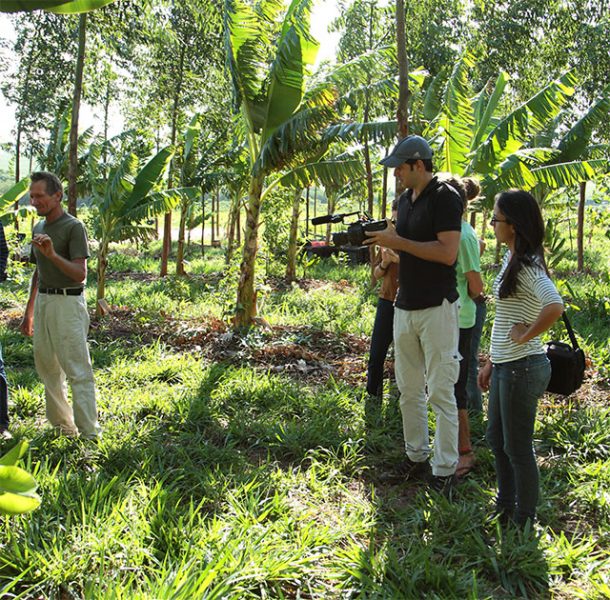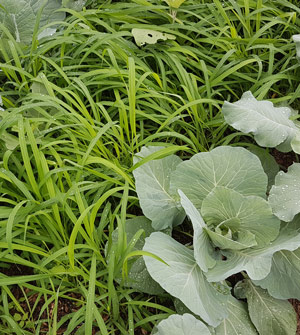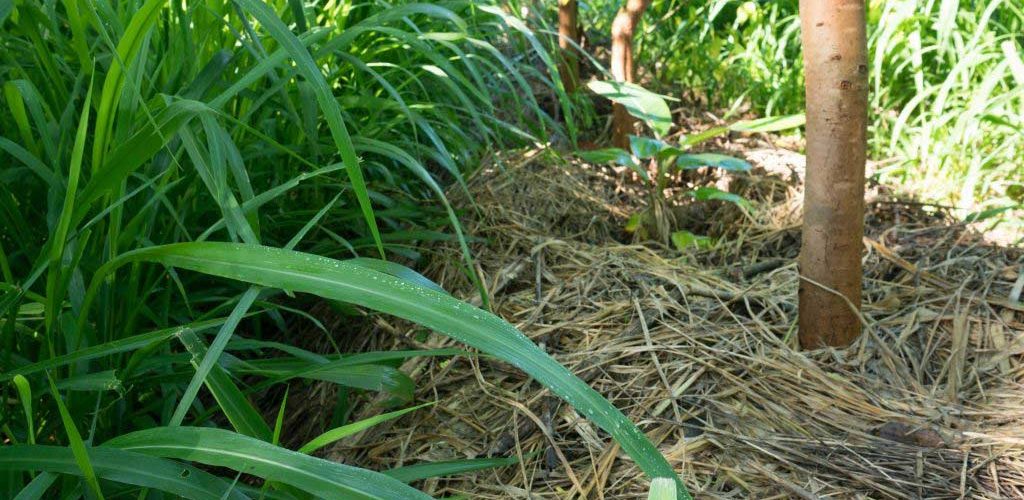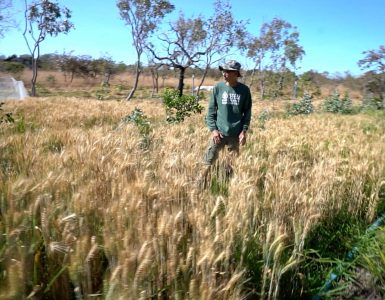Whoever follows the work of the farmer and researcher Ernst Götsch knows that he has included controversial species in his systems for the past years. In focus, two classics: grass and eucalyptus. Who hears the advice for the first time reacts with astonishment, after all, the criminal record of these plants is long. Eucalyptus is accused of drying the soil, having an allelopathic effect, apart from being exotic. Some species already carry the reputation of being invasive plants, weeds and pests. Sometimes we inherit some pre-established concepts, and we do not even stop to reflect on them. Do we have a prejudice against some plants?

I have been an eyewitness to some events and I want to share here with you, as I believe they can help us look at the grass from a new perspective. About the eucalyptus I tell in another opportunity.
Origins of some types of grasses
Coming from the African continent, the genus Brachiaria and Panicum are famous grasses for their resistance and productivity. Precisely for this reason, they are part of the list of species considered invasive. First of all, it is necessary to know the objectives of those who make these accusations. A rancher and a farmer have very different views of the grass. For the first, for example, the grass is food for cattle, for the latter is a pest that takes over the place of its cultivated plants. Light and small, their seeds travel far in the wind, on the beaks, paws and intestines of the many animals that feed on them. Due to this easy propagation and its unquestionable adaptability, these grasses were declared enemies of agriculture and against them were created all kinds of pesticides, mechanical and chemical.
As Ernst normally says, for not speaking our language, those plants cannot defend themselves

The ethical perspective of syntropy invites us to question many of the beliefs that are part of the agriculture establishment and ends up re-signifying the role of some plants.
Grass, like many “invaders,” is a consequence of degradation, not the cause of it. It is as exotic to an ecosystem as the impacts that facilitated its introduction and permanence. In many places, the natural ecosystem has lost the resilience to deal with such disturbances caused by our agro-mining activities. The species that could do the recovery of the place were already extinct, or simply can not grow there anymore – since they are naturally not adapted to those conditions.
Ernst Götsch postulates that when the original ecosystem can no longer deal with the level of destruction imposed on it, we must use species from less privileged places in water and nutrients. It means that we take advantage of those “warriors” – such as eucalyptus and grass – to begin the recovery of the place, even if later on we replace them with the native ones.
This strategy, according to Götsch, is the same performed by nature itself. In moments of crisis, nature uses its genetic plasticity to reestablish the syntropic dynamics that result from natural succession. Rather than labeling a species as harmful, we should investigate the conditions found in the “invaded” areas
Do you remember the video where Ernst explains his view on exotics? It’s worth watching it again!
how about biodiversity?
For those who say that exotic grasses invade protected areas and thus threaten local biodiversity, we again fall into the trap of prejudice. Grass does not invade shaded area (nor eucalyptus) – therefore, they are no threat to forestry biomes. Roughly, it only finds conditions to thrive in altered areas.
The grass, in this context, is one of the plants that do the first work of soil improvement. Being perennial, its roots “loosen” and restructure the soil, opening the way for water, oxygen, nutrients and all kinds of organisms, improving the place for the species that will come in the next stage of succession (just like everywhere else free from our presence). As a result, the degraded soil, which once supported only these rustic grasses, now can also welcome shrubs and some demanding trees.



Over time, a forest is formed and the grass begins to weaken due to the shade. When the forest takes over, the grass will be already gone, victim or martyr of the shadow it helped to create. Assuming this perspective, humans (and ecosystems) would benefit much more if, instead of investing time and money in a war against these “weeds,” we understood the ecological role of these plants and used them as nature does.
Natural environments know no prejudices and, as long as conditions are favorable, they adopt species from everywhere. One of the side effects of some ecological established “trues” is the creation of fetishes for certain concepts. On a planet that has been altered by us for millennia and has never seen such artificial destruction, instead of creating more wars against species, we could learn on how to handle them properly in order to bring the environment to a better level. Everyone – natives and exotics – are doing that, except the human being.
The “razor-grass” story
Before testing a species in the field, Ernst observes it in several situations. In Pará (Amazon), I had the privilege of accompanying him for years in a pioneering project of palm oil grown in agroforestry systems. There he had a clue on how to include the grass in his designs. As the mentioned system was organic, the model included species which the primary function would be the production of biomass. These plants (Tithonia diversifolia, Pueraria phaseoloides, Gliricidia sepium, Inga sp, among others) would provide large amount of organic matter to cover the tree lines, fulfilling the double usefulness of nourishing and protecting the soil. In one of the project areas, the responsible farmer made initial fertilization with a poultry litter, and possibly there were also millions of seeds of a hard-to-manage plant: Froelichia humboldtiana. The herb spread quickly between the lines of the field, disrupting the growth of major crops and fertilizer plants. In some parts, the weed formed a thick carpet and grew up the young trees. A species that also appeared spontaneously, however, did not seem to bother: a Panicum sp grass. Once in a while, it was possible to find vigorous clumps almost three meters high and, looking closely, it was noticed that in the surroundings of the grass there was no weed. It did not resist the shadow. In addition, the soil around its roots was more humid. For Ernst, the conclusion was obvious. That grass was to be broadcast everywhere. It would not only drive the weed out of the system, but it would also provide a massive amount of biomass to the system. If in that dry season the grass showed large clumps, imagine how much it would produce throughout the year, with 8 or 9 cuts? It would be a great help in the challenge of ensuring a constant production of biomass to keep the soil covered – especially in the Amazon, where the decomposition of organic matter is fast. More generous layers of the grass mulch around the tree seedlings would also prevent the approach of undesired weeds. In theory, it made sense. In practice, we cannot know. Ernst’s suggestion found a cultural barrier. That grass was hated in the region, and the name by which it is known says it all: razor-grass. As it ages, the plant becomes more fibrous and with cutting leaves. Although it was an inescapable problem, tradition spoke louder. Of course, we had to respect.
***written by Felipe Pasini | contributions of de Dayana Andrade | approved by Ernst Götsch






